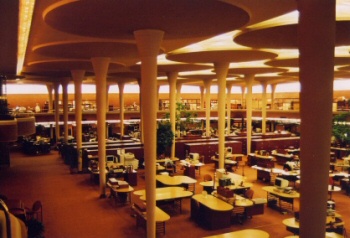Johnson Wax Building, Wisconsin, USA
 Architect
Architect
The Johnson Wax Building, situated in Wisconsin, was designed by American architect Frank Wright for the president of the Johnson Wax company. As well as being an architect, Frank Wright was also an interior designer and writer. He was born in the mid 1860 in a small town in the state of Wisconsin. Even though Wright was most famous as an architect he was a dealer in Japanese art, as well.
Frequently he would serve as both art dealer and architect to clients. Designing homes and then provide the art to fill the home. He was one practically the first architects to create custom-made furniture with a purpose and that functioned as part of the design. Frank Wright was well-known for using innovative building materials and he famously used Pyrex glass. Wright received a great deal of honorary acknowledgment for his achievements including several awards for his architecture and honorary degrees from several universities.
Design and Construction
Construction started on the Johnson Wax Building in 1936 and was finished in 1939. The building also referred to as the Johnson Administration Building is an example of a streamlined modern architectural design. It has more than 200 types of curved bricks that make up the exterior of the building and tubing made from Pyrex glass running from the ceiling to let in light. The light shines into the building through the several layers of glass tubing, but cannot be seen through. The colours Wright chose for the building Cherokee red for the furniture and floors, and cream for the mortar and columns. The entry way consists of gorgeous brass lined windows and revolving doors.
Compression and release of space was the concept Wright used in this design. The low ceilings in the parking lot created the compression of space and the rise of the ceilings when one enters the building created the release of space. Before entering the building it is somewhat compressed with a dark and low ceiling parking garage and upon entering the building the space releases into a large open entrance. This concept is remarkable. The Great Workroom has no internal walls and is the largest expanse of space in the Johnson Building. The construction created great controversies for the architect. At that time, the columns at first did not meet with building codes. Additionally, it was hard to seal the glass tubing installed in the roof to prevent leaking.
In spite of these problems, Johnson was extremely pleased with the design. Therefore, in 1944, he commissioned Wright to design the 14 story Research Tower. When the tower was added the building was made even more impressive. Although the tower is no longer in use due to the changes in safety codes, the company is committed to preserving the tower.
History
In 1935, Herbert Johnson wanted to construct new offices to give his company a more modern image. He sought the help of Frank Wright. The company wanted the project to project the American dream, where the workers are happy and are united as one family. The Johnson Building and tower are on the register of National Historic Places. The building and the tower were chosen by the Institute of Architects to be retained as examples of the architect's contribution to American culture. In 1976, both buildings were designated Historic Landmarks. In 2008, both the building and the tower were submitted, along with nine other Wright properties, to a tentative list for Heritage Status.
Current Use
The Johnson Wax Building located in Racine, Washington and currently still is the administration building and headquarters, as well as a research laboratory for the company Johnson & Son. It has been a family run business for more than 100 years.
